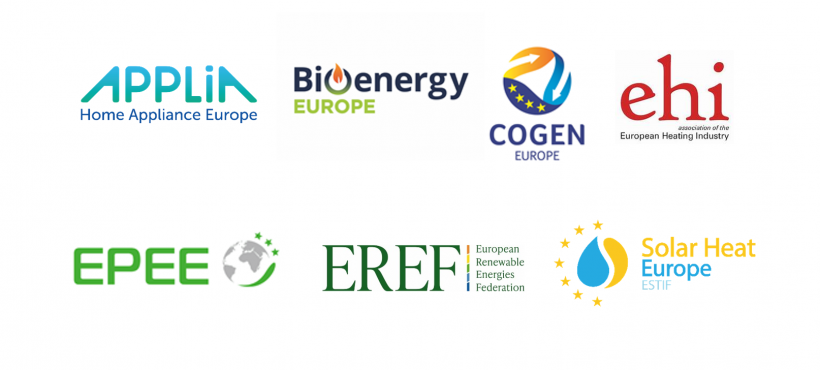Solar Heat Europe and other European associations launched a joint position paper on the modernisation of old and inefficient heating & cooling systems, highlighting key aspects to consider in the context of the upcoming Fit for 55% Package that will be published by the European Commission on July 14th.
Background
To curb our emissions and keep temperature levels well below +1.5oC, in accordance with the EU’s Green Deal and our international obligations, the replacement and modernisation of our heating and cooling systems is vital.
In October 2020, the European Commission published its Renovation Wave Strategy, recognising the decarbonisation of heating and cooling in buildings as a priority: “modernising the heating and cooling systems of buildings is essential to decarbonise the EU building stock, to deploy local renewable energy potential and to reduce the EU’s dependence on imported fossil fuels.”
Furthermore, according to the Commission’s impact assessment for the 2030 Climate Target Plan, the residential sector would experience the highest reduction in fossil energy demand in heating and cooling. To ensure the new 2030 climate target of 55% is achieved, CO2 emissions from buildings will need to be reduced by 60% by 2030 (compared to 2015 levels), thus requiring immediate action.
Moreover, there is recognition that most of the existing building stock will be standing in 2050. For this challenge to be addressed, according to the Commission’s Long Term Decarbonisation Strategy, a diverse mix of energy efficient and renewable solutions will need to be deployed[3]. In parallel, the share of renewable energy in heating and cooling needs to be increased substantially, as foreseen in the revised Renewable Energy Directive (REDIII).
Finally, although the latest reports from the European Environment Agency (EEA) show that air quality is improving in Europe, more still needs to be done to enhance the current situation. If the EU is to align its air-quality objectives with the WHO air pollution limits it will be imperative to modernise Europe’s heating and cooling stock.
The European heating stock
Buildings represent 40% of EU’s energy consumption, with space heating and domestic hot water accounting for about 80% of the total energy use in European households. Two thirds of this energy is currently produced with old and inefficient systems based on fossil fuels, which is why, particular attention must be given to accelerating and supporting the modernisation of the installed heating stock. Replacing obsolete systems with highly efficient and renewable-based appliances is pivotal to achieve Europe’s decarbonisation goals. Furthermore, securing sufficient funding for these replacements and adequate incentives to appliance owners will be key, and it will also support the competitiveness of EU industries in the renewables and energy efficiency fields.
Overall, about 60% of total appliances are inefficient and would – according to current labelling standards – fall into label classes C, D, or even lower ones. In addition, the average age of heaters in Europe is about 25 years and given the risk of replacing inefficient heating systems with similarly inefficient ones when they break, its planned replacement with highly efficient and renewable alternatives is crucial before 2030. Ecofys has found that currently the yearly replacement rate of old heating systems is approximately 4%. With a rate of 5% Europe’s CO2 emissions reduction would rise to 40%, which would still be below the new 55% emissions reduction target for 2030. Consequently, a higher replacement target, of at least 6% per year, is urgently required.
Fit for 55 – A replacement target and incentives to underpin heating and cooling decarbonisation
Fit for 55 must clearly acknowledge the “heating and cooling dimension” as a key part of building renovation and introduce a clear requirement for the replacement of old and inefficient heating and cooling appliances with highly-efficient and renewable-based systems. Therefore, we strongly urge the adoption of a target of at least 6% annual replacement rate or more, which will help achieve the renewed level of climate ambition for 2030.
Setting a replacement target will not only ensure a faster uptake of energy efficient and renewable-based heating and cooling solutions but could also ensure that upgrades for building envelopes, heating and cooling appliances, and technical building systems will be complementary. This replacement target is urgently needed and should be equally promoted.
It is essential that heating and cooling decarbonisation is based on both the affordability principle and a fair distribution of costs. In order to achieve this, there should be adequate financing and incentives for a diverse mix of efficient and renewable-based solutions, which will ensure a cost-effective reduction of emissions and affordable choices for consumers. This is particularly relevant for the worst performing buildings and financially vulnerable households, and it will be key to guaranteeing higher public acceptance for the energy transition.
Benefits of replacing old heating appliances with new, efficient, and renewable-based ones
Further promotion of the replacement of old heating and cooling systems with new, efficient, and renewable-based ones will have key environmental, economic, and societal benefits.
Firstly, this will strongly reduce carbon emissions and substantially support the achievement of the 2030 and 2050 climate and energy targets.
Secondly, a higher replacement rate of heating appliances will also have a direct and positive impact on energy poverty, resulting in lower energy bills and ensuring that no citizen or business is left behind during the transition. Often, it is the most fragile households that pay the highest prices for energy compared to their possibilities, especially for heating needs. Making efficient and renewable-based heating and cooling systems accessible to everyone, including lower-income households and the worst performing buildings, through scrappage schemes and other incentives, will ensure the just nature of this transition.
Thirdly, upgrading heating and cooling systems should be a key part of any effective renovation action. Replacing heating and cooling systems creates significant energy, carbon, and economic savings in the short term. Additionally, these upgrades make it easier to implement other renovation steps without compromising building owners’ choices. As such, the planned replacement of heating and cooling appliances is an essential measure, that shall be considered in both staged and deep renovations. Increasing the replacement rate for heating and cooling systems will also create direct jobs (manufacturing) and indirect jobs (distribution, installation, maintenance) across Europe, whilst increasing its energy independence.
Finally, the switch to modern heating and cooling appliances will ensure better air quality and consequently improvements for human health related to air pollution.


Leave a Reply